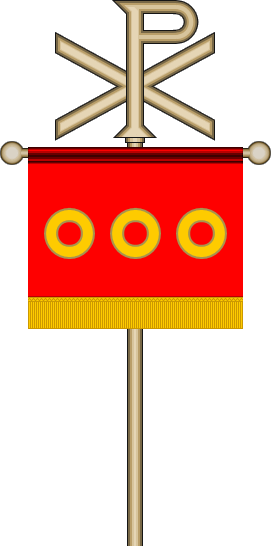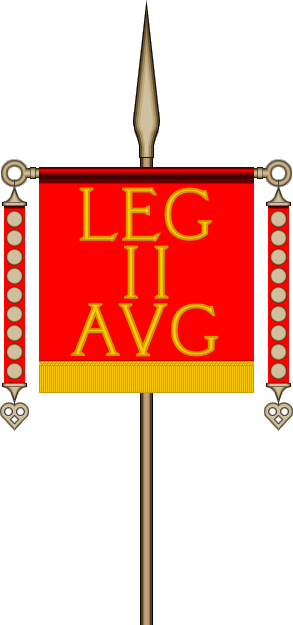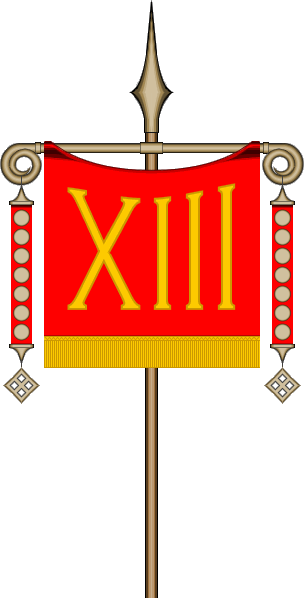
Labarum of Emperor Constantine
image by Eugene Ipavec, 29 June 2006

Last modified: 2013-07-30 by rob raeside
Keywords: italy | rome | roma | roman empire | vexillium | labarum |
Links: FOTW homepage |
search |
disclaimer and copyright |
write us |
mirrors
See also:

Labarum of Emperor Constantine
image by Eugene Ipavec, 29 June 2006
SPQR has been used on several modern reconstructions of Roman
flags and vexilloids, see for instance the eagle (aquila)
standard on the page of the re-enactment group "Legio
XXIV" (<www.legionxxiv.org>).
However, as far as it is known, the SPQR, though used widely in
inscriptions, was never used on any kind of flags in antiquity.
The main reason would be: These flags were basically military
standards for the respective military units, and not *national*
flags. As the soldier all belonged to the Roman army, which was
in essence marked by the whole system of flags, they didn't need
a reminder. These flags (vexilla as well as signa of different
units) contained other inscriptions, though; in most cases these
would be short forms of the name of the unit, for instance
"LEG II AUG" for "Legio II Augusta", a legion
stationed in Britain. A vexillum with this inscription can be
seen on the "Bridgeness distance slab" from the time of
emperor Antoninus Pius (138-161 AD)
Marcus Schmoger, 14 April 2002
From 'Flags' by A. Macgeorge, Glasgow, 1881 [mcg81]:
"The vexillium was a standard composed of a square piece of
cloth fastened to a cross bar at the top of a spear, sometimes
with a fringe all round, and sometimes fringed only below, [see here], or without a fringe,
but draped at the sides, [see here].
When placed over the general's tent it was a sign for marching,
or for battle. The labarum of the emperors was similar in form,
and frequently bore upon it a representation of the emperor,
sometimes by himself and sometimes accompanied by the heads of
members of his family. [ ] That which Emperor Constantine bore
was what, in his time, was the only recognized Christian emblem -
the first two letters of our Lord's name - the Greek X and P.
[see here]. The labarum was
made of silk. The term is sometimes used for other standards, and
its form may be recogized in the banners carried in
ecclesiastical processions. The labarum, like the vexillium, had
sometimes fringes with tassels or ribbons."
David Prothero, 7 March 2006
See modern creations for re-enactment at <www.legionxxiv.org>
and <www.larp.com>
for more details.
Jan Mertens, 8 March 2006
Most modern reproductions seem to favor designs with a graphic
representation of the legion's symbol in addition to the
lettering - does this have a historical basis, and are there any
period depictions of such a vexillum?
Also, according to a paper on the slab at <ads.ahds.ac.uk>,
"One example of the cloth [vexillum] survives and is now in
the Pushkin Museumof Fine Art in Moscow (Rostovtzeff 1942). This
was acquired, and therefore presumably found, in Egypt."
Does anyone know if there are any photos of this online?
Eugene Ipavec, 30 June 2006

image by Eugene Ipavec, 30 June 2006
The vexillum of the Legio II Augusta is based on the
bas-relief on the "Bridgeness distance slab" in the UK,
visible at <www.scran.ac.uk>.
Eugene Ipavec, 30 June 2006

image by Eugene Ipavec, 30 June 2006
The vexillum of the Legio XIII Gemina. I used a period source;
the vexillum is shown on a 3rd century coin at <en.wikipedia.org>.
The details came from the photo of a modern reconstruction at Encarta,
which may perhaps be more authentic than those of reenactors.
Eugene Ipavec, 23 March 2006
A special case must be Marcus Agrippa's flag, awarded by
Augustus. This is mentioned in Suetonius' "The Twelve
Caesars", I quote from the Robert Graves translation (rev.
Michael Grant), issued in Penguin Classics, ch. 25 of 'Augustus':
"Marcus Agrippa earned the right to fly a blue ensign in
recognition of this naval victory off Sicily."
I can provide more bibliographical info here but the interesting
thing is to compare this version with others (and with the
original text).
See, for instance at <www.gutenberg.org>
"The Lives of the Twelve Caesars", a Gutenberg e-text
(translation Alexander Thomson rev. T. Forester): XXV. (...)
"He presented M. Agrippa, after the naval engagement in the
Sicilian war, with a sea-green banner."
Jan Mertens, 7 February 2005
The original text refering to the vexillum of Marcus Agrippa
is indeed from C. Suetonius Tranquillus: "De Vita
Caesarum", chapter 25: "M. Agrippam in Sicilia post
navalem victoriam caeruleo vexillo donavit." [1] (He awarded
M. Agrippa in Sicily after the naval victory with a sky-coloured
vexillum) (my translation)
It is important to stress the fact, that this vexillum (flag) was
obviously awarded as a military decoration, because in the
sentences before Suetonius described the other military
decorations that had been awarded (several crowns, collars etc.).
There are other instances known of the awarding of a vexillum as
military decoration to high-ranking officers [2]. However, it is
totally unknown, how this decoration was displayed, i.e. if the
actual flag was openly displayed or if some miniature form was
worn with the uniform, for instance.
The colour of the vexillum awarded to Agrippa is certainly a
problem, because the word "caeruleus" literally means
"sky-coloured". The word, however, was used in a wide
variety of contexts, meaning very different, usually rather dark
colours: "dark-colored, dark blue, dark green, cerulean,
azure, dark, gloomy, dun, sable, black, dark green, green,
greenish". [3]
Sources:
[1] C. Suetonius Tranquillus: De Vita Caesarum. at <www.perseus.tufts.edu>.
[2] [mxf81].
[3] Charlton T. Lewis, Charles Short, A Latin Dictionary. at <www.perseus.tufts.edu>.
Marcus Schmöger, 7 February 2005
As far as my limited knowledge goes, the word vexillum
referred specifically to the flag carried by the Roman cavalry.
If there was no other usage, would it not be reasonable to assume
that this decoration was displayed in a similar manner? For
example that he could have been preceded by a bearer carrying
this caeruleun vexillum before him in processions or on parades
like the triumph? Did he have one for this victory? Presumably we
can only speculate at this distance in time unless some one can
come up with a classical reference explaining the whole thing.
Andries Burgers, 8 February 2005